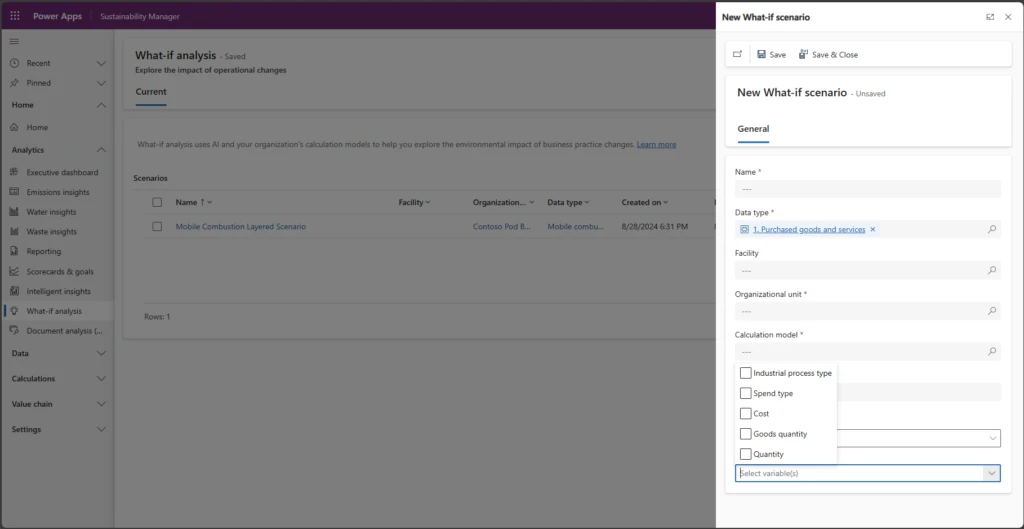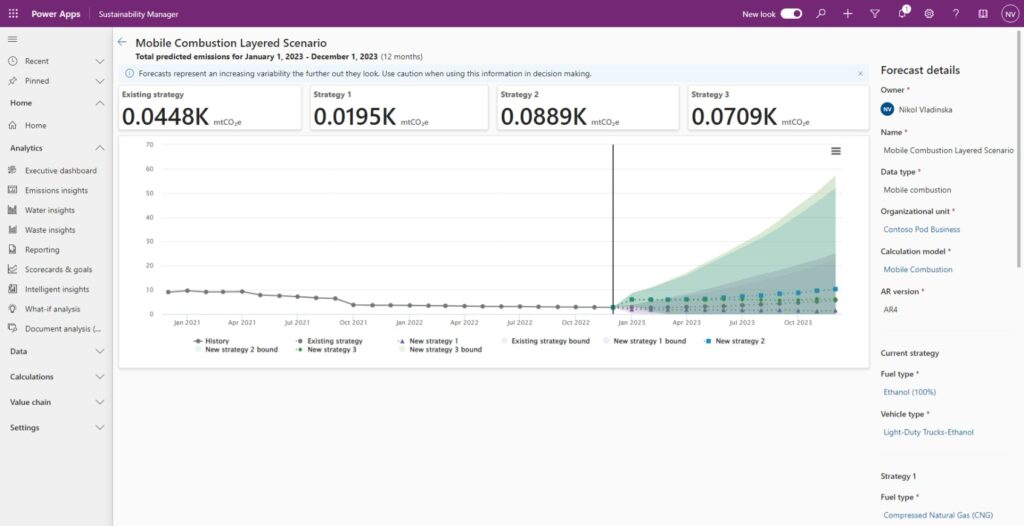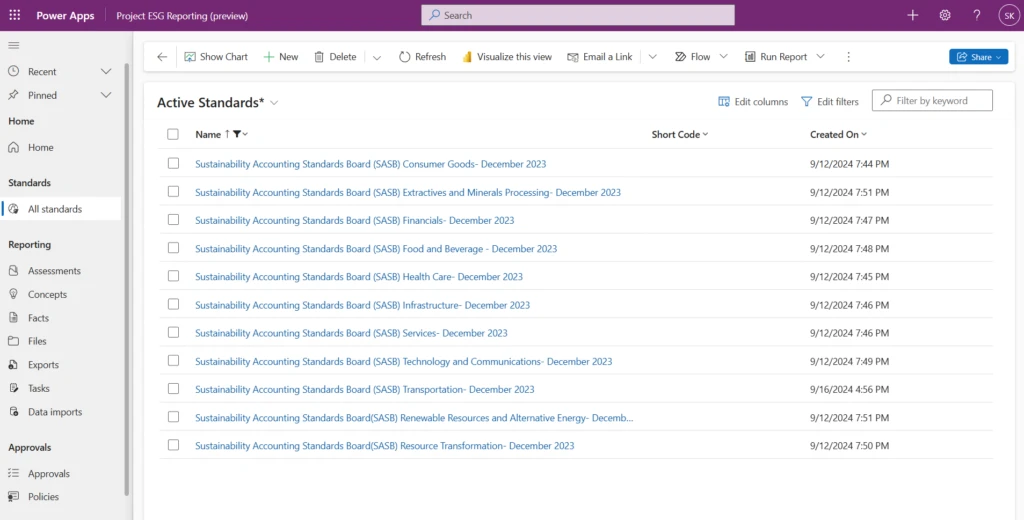
Microsoft Cloud for Sustainability: Drive specific reduction and reporting targets with AI
To help accelerate sustainability progress at speed and scale, Microsoft is actively expanding AI in our Microsoft Cloud for Sustainability. In this blog, we’ll explore the latest advancements, including enhancements to AI-powered analytics and reporting in Microsoft Sustainability Manager, the general availability (GA) of what-if analysis and intelligent insights, updates to Project ESG Reporting, and other key updates. Find out how these tools can help you make data-driven decisions, streamline reporting, and accelerate progress. Using them, you can not only help meet reporting requirements, but also gain a competitive edge in your sustainability efforts.

Microsoft Cloud for Sustainability
Record, report, and reduce your environmental impacts using the power of data and AI.
Tighten your emissions goals with what-if analysis—now generally available
Conducting what-if analysis in Sustainability Manager allows organizations to evaluate their current carbon emission trends against the projected effects of altering variables within their business practices. Put simply, companies can intelligently forecast the long-term effects of altering their practices on their emissions footprint. With this GA release, the what-if analysis capability is enhanced to help businesses advance toward their objectives more quickly.
Organizations can now extend their forecast horizons longer, based on the amount of historical data incorporated, by utilizing the what-if analysis feature. Typically, the forecast horizon spans about half the duration of the historical data used. An organization with four years of historical data, for example, can expect to see a forecast of up to two years. This allows businesses to create more informed and strategic plans for reducing their carbon footprint. By estimating the long-term effects of different emission reduction strategies, companies can help identify actions to take toward meeting reporting requirements and enhancing their progress toward goals.
With increased customizability, organizations can select specific fields to manipulate within forecasts, rather than being restricted to the default fields available in earlier versions. Fields can also be layered together to enable the prediction and comparison of different reduction strategies’ outcomes in a single view. Up to three forecasts can be layered to help identify optimal reduction opportunities.

Figure 1. Customizable what-if analysis allows users to alter variables to deliver more precise insights.
With customizable what-if analysis, organizations ultimately enable greater precision and flexibility in their sustainability efforts. They can make more informed decisions, tailored to specific needs and goals, and drive more targeted progress toward reporting and long-term sustainability objectives. Moreover, through intelligent forecasting, they can preempt potential issues and sharpen strategic planning to help save time and resources.

Figure 2. With layered forecasting, organizations can estimate and compare the outcomes of different reduction strategies in a single view.
Strengthen analysis and decision-making with intelligent insights
Building on the predictive capabilities of what-if analysis, intelligent insights in Microsoft Sustainability Manager further assists decision-making by enabling deep, AI-driven data analysis and actionable insights. The intelligent insights capability, also now generally available, helps organizations analyze complex data patterns and drive meaning from data to make more informed decisions. This feature helps identify data trends and gaps as well as hidden opportunities for efficiency, allowing businesses to optimize costs, form targeted strategies, and make better progress.
Used with what-if analysis to simulate different scenarios, businesses can assess the potential impact of various decisions, evaluate the outcomes of different strategies before implementation, and understand potential risks and benefits. As a result, businesses can plan more effectively and avoid potential pitfalls.
Overall, the intelligent insights capability provides businesses with a competitive edge by enabling them to make smarter, more data-driven decisions. By leveraging AI to help analyze complex data patterns, businesses can uncover valuable insights that drive better outcomes and support long-term success. Whether it’s optimizing operations, accelerating sustainability progress, or responding to market expectations, intelligent insights offer a wealth of benefits that can help transform the way businesses operate.
Tackle multiple reporting standards with Project ESG Reporting
Driving business value with ESG data readiness
Read the blogProject ESG Reporting (preview) offers a collection of templates, frameworks, and directives that can be populated and reused for future reports, helping organizations streamline the reporting process. These tools are designed to support organizations in their sustainability reporting journeys, making it easier to track progress, identify areas for improvement, and communicate their sustainability efforts effectively.
New SASB templates (preview) enable drafting responses to Sustainability Accounting Standards Board (SASB) Standards across a wide array of industries. Overseen by the International Sustainability Standards Board (ISSB), SASB Standards facilitate reporting on industry-related sustainability risks and opportunities over short, medium, or long terms, across 77 industries. Get more information about the templates for SASB and other standards.

Figure 3. Organizations can streamline the reporting process for SASB and other standards, using Project ESG Reporting (preview).
Improve greenhouse gas calculations with DEFRA emission factors
Microsoft Sustainability Manager also now includes Department for Environment, Food, and Rural Affairs (DEFRA) 2023 and 2024 emission factors in the factor library. With DEFRA factors, organizations can calculate greenhouse gas (GHG) emissions from a range of activities, including energy use, water consumption, waste disposal, recycling, and transport activities.
Learn more about sustainability solutions with Microsoft
Bookmark Microsoft Industry Blogs: Sustainability for the latest updates, including new capabilities in Microsoft Cloud for Sustainability.
Discover solutions with Microsoft Sustainability Manager.
Explore the Microsoft Cloud for Sustainability Community, where you can find answers to questions and connect with peers and experts.




